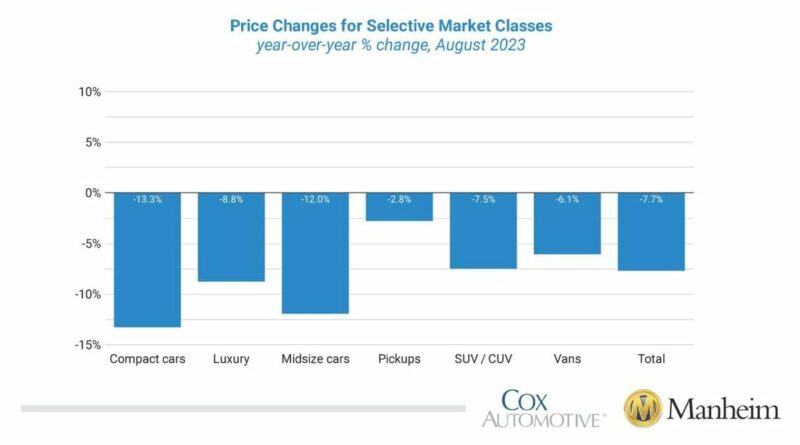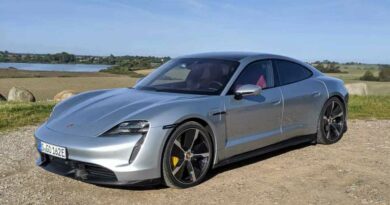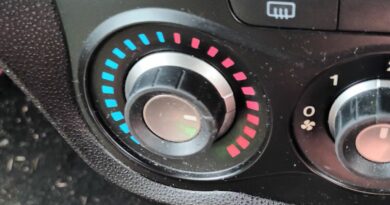Wholesale Used-Vehicle Prices and Sales Holding Steady
Compared to August 2022, pickups, vans, and SUVs lost less than the industry, down 2.8%, 6.1%, and 7.5%, respectively. Compact cars performed the worst year over year, down 13.3%, followed by midsize cars at 12%, and luxury down 8.8%.
Graphic: Cox Automotive / Manheim
Wholesale used-vehicle prices (on a mix, mileage, and seasonally adjusted basis) increased 0.2% in August from July, according to a report from Cox Automotive and Manheim released Sept. 8.The Manheim Used Vehicle Value Index (MUVVI) rose to 212.2, down 7.7% from a year ago.
“Like last month’s note, the current Manheim Index level of 212.2 is barely above that of the 212.1 measure seen in August 2021,” said Chris Frey, senior manager of economic and industry insights for Cox Automotive, in a recent news release. “Used market conditions have been quite consistent for a few months and are not likely to change much, even with the larger push toward balance; sales are slightly stronger than expected, inventory remains tight, and prices are holding at levels around 6% below last year at the same time. These factors are expected to prevent any substantial decline in wholesale prices through year-end.”
The seasonal adjustment minimized August’s increase. The non-adjusted price change in August increased by 0.9% compared to July, moving the unadjusted average price down 7.5% year-over-year. In August, Manheim Market Report (MMR) values saw below-average weekly declines as the month started and ended, with increases in between. Over the last four weeks, the Three-Year-Old Index increased an aggregate 0.2%.
More News: Used Vehicle Supply Drops on Strong Sales
During August, daily MMR Retention, which is the average difference in price relative to the current MMR, averaged 99.3%, meaning market prices were slightly below MMR values. The average daily sales conversion rate increased to 57.5%, which is much closer to normal for the time of year and higher than what was recorded over the last three months. For context, the daily sales conversion rate averaged 60% in August 2019.
Buying activity increased in the month, while supply remained limited. The sales conversion rate in August was higher than in July at 48.9%. August 2022 saw a 49.9% rate.
The major market segments again produced seasonally adjusted prices that were lower year over year in August.
Compared to August 2022, pickups, vans, and SUVs lost less than the industry, down 2.8%, 6.1%, and 7.5%, respectively. Compact cars performed the worst year over year, down 13.3%, followed by midsize cars at 12%, and luxury down 8.8%.
Compared to last month, pickups gained more than the industry, up 0.6%, as did vans, at 1.2%. Both compact and midsize cars lost against the industry in August, down 0.6% and 0.5%, respectively. Luxury and SUVs gained little, both up 0.1% from last month.
Used Retail Vehicle Sales Increased in August
Assessing retail vehicle sales based on observed changes in advertised units tracked by vAuto, Cox estimates that used-vehicle retail sales in August were up 5% compared to July, and the year-over-year comparison with 2022 improved.
Used retail sales are estimated to be up 0.8% year-over-year in August, which was the best performance since February.
The average retail listing price for a used vehicle moved down 0.4% over the last four weeks. Using estimates of used retail days’ supply based on vAuto data, an initial assessment indicates August ended at 43 days’ supply, down six days from 49 days at the end of July, and nine days lower than how August 2022 ended at 52 days.
Leveraging Manheim sales and inventory data, wholesale supply is estimated to have finished July at 24 days, down three days from the end of July and down five days from August 2022’s estimate of 30 days.
August’s total new-light-vehicle sales were up 17.1% year over year, with one more selling day versus August 2022.
By volume, August new-vehicle sales were up 2.2% month over month. The August sales pace, or seasonally adjusted annual rate (SAAR), came in at 15 million, an increase of 13.6% from last year’s 13.2 million but down 4.5% from July’s virtually unrevised 15.7 million pace.
Combined sales into large rental, commercial, and government fleets increased 34% year over year in August. Sales into rental fleets were up 102% year over year, sales into commercial fleets were up 1.2%, and sales into government fleets were up 39%. The fleet market share was estimated to be 15.6%, a gain of 2.2% over last year’s share but down 0.4% from July’s 16% market share.
Including an estimate for fleet deliveries into dealer and manufacturer channels, the remaining retail sales were estimated to be up 13.9%, leading to an estimated retail SAAR of 12.6 million, up 0.9 million from last year’s 11.5 million pace and down 0.6 million from last month’s 13.2 million pace.
Rental Risk Prices Mixed, Mileage Down in August
The average price for rental risk units sold at auction in August declined 5.9% year over year. Rental risk prices increased by 1.4% compared to July. Average mileage for rental risk units in August (at 55,100 miles) was down 2.5% compared to a year ago and down 9.0% from July.
Measures of Consumer Confidence Declined in August
The Conference Board Consumer Confidence Index declined by 6.9% in August, as views of both the present situation and future expectations declined. Consumer confidence was up 2.4% year-over-year. Plans to purchase a vehicle in the next six months declined modestly but remained up year over year.
The confidence index did not fall as much during the pandemic as the sentiment index from the University of Michigan.
Both series declined in August after improving in June and July. The Michigan index declined 2.9% for the month but was up 19% year over year. The consumer’s view of vehicle-buying conditions was unchanged from July and at the best level since February.
The daily index of consumer sentiment from Morning Consult also measured declining sentiment in August, as the index declined 2.3% from the end of July.
Expectations of the future improved the most in June and July but lost ground in August. Gas prices increased in July and again in August but saw some relief in the final 10 days of August. The national average price for unleaded gas increased 1% in August to $3.82 per gallon, which was unchanged year-over-year, according to AAA.
Source: Read Full Article



